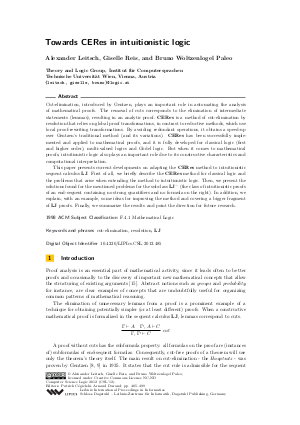Towards CERes in intuitionistic logic
Authors Alexander Leitsch, Giselle Reis, Bruno Woltzenlogel Paleo
-
Part of:
Volume:
Computer Science Logic (CSL'12) - 26th International Workshop/21st Annual Conference of the EACSL (CSL 2012)
Part of: Series: Leibniz International Proceedings in Informatics (LIPIcs)
Part of: Conference: Computer Science Logic (CSL) - License:
 Creative Commons Attribution-NonCommercial-NoDerivs 3.0 Unported license
Creative Commons Attribution-NonCommercial-NoDerivs 3.0 Unported license
- Publication Date: 2012-09-03
File

PDF
LIPIcs.CSL.2012.485.pdf
- Filesize: 444 kB
- 15 pages
Document Identifiers
Subject Classification
Keywords
- cut-elimination
- resolution
- LJ
Metrics
- Access Statistics
-
Total Accesses (updated on a weekly basis)
0Document
0Metadata
Abstract
Cut-elimination, introduced by Gentzen, plays an important role in automating the analysis of mathematical proofs. The removal of cuts corresponds to the elimination of intermediate statements (lemmas), resulting in an analytic proof. CERes is a method of cut-elimination by resolution that relies on global proof transformations, in contrast to reductive methods, which use local proof-rewriting transformations. By avoiding redundant operations, it obtains a speed-up over Gentzen's traditional method (and its variations). CERes has been successfully implemented and applied to mathematical proofs, and it is fully developed for classical logic (first and higher order), multi-valued logics and Gödel logic. But when it comes to mathematical proofs, intuitionistic logic also plays an important role due to its constructive characteristics and computational interpretation. This paper presents current developments on adapting the CERes method to intuitionistic sequent calculus LJ. First of all, we briefly describe the CERes method for classical logic and the problems that arise when extending the method to intuitionistic logic. Then, we present the solutions found for the mentioned problems for the subclass LJ- (the class of intuitionistic proofs of an end-sequent containing no strong quantifiers and no formula on the right). In addition, we explain, with an example, some ideas for improving the method and covering a bigger fragment of LJ proofs. Finally, we summarize the results and point the direction for future research.
Cite As Get BibTex
Alexander Leitsch, Giselle Reis, and Bruno Woltzenlogel Paleo. Towards CERes in intuitionistic logic. In Computer Science Logic (CSL'12) - 26th International Workshop/21st Annual Conference of the EACSL. Leibniz International Proceedings in Informatics (LIPIcs), Volume 16, pp. 485-499, Schloss Dagstuhl – Leibniz-Zentrum für Informatik (2012)
https://doi.org/10.4230/LIPIcs.CSL.2012.485
BibTex
@InProceedings{leitsch_et_al:LIPIcs.CSL.2012.485,
author = {Leitsch, Alexander and Reis, Giselle and Woltzenlogel Paleo, Bruno},
title = {{Towards CERes in intuitionistic logic}},
booktitle = {Computer Science Logic (CSL'12) - 26th International Workshop/21st Annual Conference of the EACSL},
pages = {485--499},
series = {Leibniz International Proceedings in Informatics (LIPIcs)},
ISBN = {978-3-939897-42-2},
ISSN = {1868-8969},
year = {2012},
volume = {16},
editor = {C\'{e}gielski, Patrick and Durand, Arnaud},
publisher = {Schloss Dagstuhl -- Leibniz-Zentrum f{\"u}r Informatik},
address = {Dagstuhl, Germany},
URL = {https://drops.dagstuhl.de/entities/document/10.4230/LIPIcs.CSL.2012.485},
URN = {urn:nbn:de:0030-drops-36922},
doi = {10.4230/LIPIcs.CSL.2012.485},
annote = {Keywords: cut-elimination, resolution, LJ}
}
